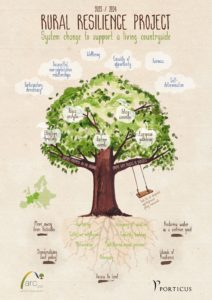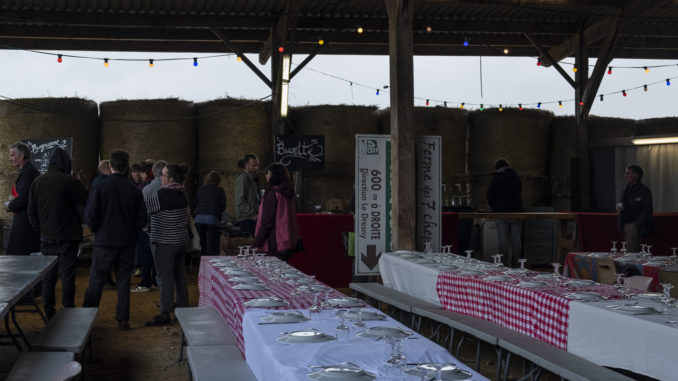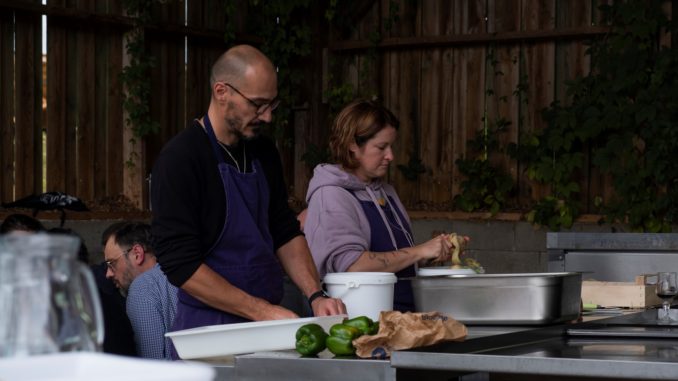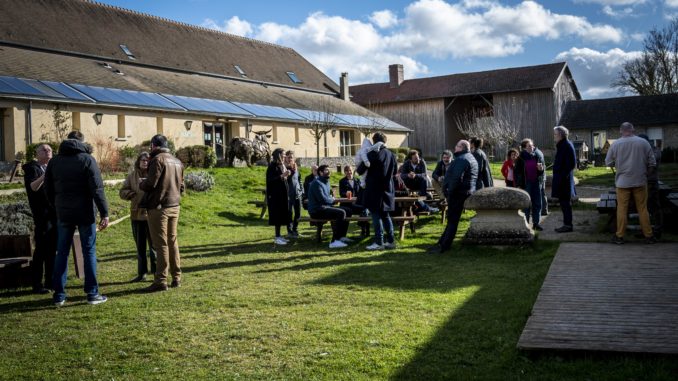This article first appeared on ARC2020.eu. ARC2020 is a platform for agri-food and rural actors working towards better food, farming, and rural policies for Europe.
 In bottom-up movements towards a more socio-ecological countryside, food is a key driver of territorial dynamics. This was a finding of our research on the ground in phase 1 of the Rural Resilience project.
In bottom-up movements towards a more socio-ecological countryside, food is a key driver of territorial dynamics. This was a finding of our research on the ground in phase 1 of the Rural Resilience project.
In phase 2, we ask how a top-down tool such as France’s Territorial Food Programmes can help to democratise local food policy. It’s a state-led initiative, but precariously funded, and no guarantee of healthy, organic food for the community. In the best case scenario, communities take food into their own hands. How does the French infrastructure compare to Germany’s Food Policy Councils?
Part 1 of a policy analysis by the Rural Resilience project.
Background
“The EU can and must lead a wider food system revolution, and the proposal for a Sustainable Food Systems Law announced in the Farm to Fork strategy and expected for the end of 2023 represents a key opportunity to initiate this” (EEB Sustainable Food Systems Law report)
The Green Deal and Farm to Fork Strategy may not be on the radar for many French people, but 2020 shone a historic spotlight on local food supplies with COVID 19 lockdowns and food shortages.
Yet numerous French municipalities and other local actors had been working towards this slow (r)evolution all along, in some cases for more than a decade, ahead of the ‘Law for the Future’ on 13 October 2014. It was article 39 of this agriculture, food and forestry law that provided for Territorial Food Programmes (Projets Alimentaires Territoriaux – PAT). In the runup to its voting in, local food programmes were promoted by the Regions in France (approximate equivalent to Landers in Germany).
In July 2014, the Association des Régions de France [with a broad Left majority, as had the French government at the time] adopted the Rennes declaration for ‘local food systems’. This is an important detail since the Regions are one of the main funders of projects that touch the wider economy. Additionally, in 2014 France’s Regions became the administrators of EAFRD funding, including LEADER programmes, for the development of environmentally friendly agriculture and financial support of rural development via local actors.
All in all, the institutional climate seemed very promising for the budding Territorial Food Programmes (PAT) – the French equivalent of Food Policy Councils (Ernährungsräte) in German-speaking countries. However, has the rather French character of the PATs brought with it advantages such as funding to anchor structural implementation? Not necessarily. [See part 1 of this analysis below.] If the money available still seems (well) short of the stated ambitions, to what extent does the mobilisation and creativity of communities have to compensate for this handicap? And above all, what type of territories in France present the optimal strategic and operational alignment between administrations, authorities and satisfied user citizens? [coming up in part 2 of this analysis].
“Siloed approach to food policy has created a policy landscape characterised by conflicting objectives and measures, and in some cases actual policy gaps”
(EEB Sustainable Food Systems Law report)
One of most glaring gaps is the thorny question of financing, an overarching theme of this article.

Adequate financing could be an antidote to the risk of institutional rut. Photo: Adèle Violette
Institutionalisation
In 2018, five years before the ‘renationalisation’ of the CAP, researchers studied the phenomenon of France’s Territorial Food Programmes, which took effect long before the legislation entered the lawbooks. They proposed a definition:
“PATs therefore present themselves as collective territorial food programmes, strongly anchored locally; founded on a multi-partner approach; based on a shared diagnosis of agriculture and food in the territory; centred on an objective of quality, which can be declined on the level of the ethical, environmental, health, nutritional, taste; they are transversal” (Territorial Food Programmes: Between change, tradition and stasis)
Figure 1, which neatly summarises this article, paints a delightfully clear picture of the realities of Territorial Food Programmes that will ring true for local practitioners and decision makers.
| Scenario 1: Institutional rut | The Territorial Food Programme procedure is part of the vocabulary and communications of large urban municipalities. Financial disengagement of the State and certain Regions paves the way for the best resourced local authorities to establish a territorial food strategy: resources for animation, installation of new entrant farmers, supports for school canteens. Other local authorities are constrained in their choices and must prioritise their usual work. |
| Scenario 2: Constellation of local food democracies
|
Civil society (citizen associations, the Social and Solidarity Economy, producer and consumer organisations, etc.) takes the initiative in bringing together food-related actors and dynamics, at community level, while managing to contain the effects of siloed thinking and competition. Local authorities agree to support them, politically and financially, and to contribute expertise without necessarily dominating or instigating. Issues of health, the environment and access to quality food for all are at the heart of the collective work. |
| Scenario 3:
Changing everything to change nothing
|
The organisations that are least open to change organise to take control of Territorial Food Programmes procedures. In particular, the dominant farming organisations [Chambers of Agriculture] push the debate in a restrictive direction, where production and producer income issues dominate. Local – meaning geographical areas ranging from departmental to national depending on circumstances – is the most important in questions of the intrinsic and environmental quality of food. |
Figure 1: Scenarios of Territorial Food Programmes. Source: Territorial Food Programmes: Between change, tradition and stasis
The takeaway: there is a risk of institutional rut, even for municipalities that are close to the realities on the ground. While the (technical and unsettled) question of finance is beyond the scope of the paper cited above, the researchers suggest that adequate financing could be an antidote.
This brings us to the French CAP Strategic Plan (NSP 2023-2027), which extols the virtues of Territorial Food Programmes, at least in its initial assessment (diagnostic). The NSP notes that these programmes can help young farmers starting out, and can boost a key objective for French agriculture: 1 in 5 farmers in short supply chains. (Note: the idea of re-localising food supply chains first emerged over three decades ago, when big changes in the CAP were announced with milk quotas, and when farmers’ incomes were threatened.)
Yet the NSP makes no mention of Territorial Food Programmes in its annexes on financing, re-territorialising food, and short supply chains.

Even under the most ambitious recommendations, state funding for Territorial Food Programmes would barely buy a potato peeler per household per year. Photo: Canva
Funding: COVID recovery to the rescue
To understand by what miracle these territorial initiatives can be funded, we have to wait for a report by Senator Frédéric Marchand in July 2022: Territorial Food Programmes – Faster, Higher, Stronger.
“Territorial Food Programmes, together with the dynamics initiated by France Relance [recovery package], are at the crossroads and re-territorialisation of our sustainable and resilient food systems, which has become with the COVID Crisis, the international crisis and its consequences on our daily lives, a subject that is more than priority”
Territorial Food Programmes – Faster, Higher, Stronger
The report states that for Territorial Food Programmes, food policy had a “budget of 1.8 million euros year after year”. In 2021 (year 2 of COVID), this initial budget allocated by the Ministry of Agriculture and Food Sovereignty (MASA) was beefed up by €7.8m from the France Relance post-COVID recovery package, and €4.1m from ADEME (government agency for ecological transition) for project engineering studies. This total investment of €13.7m on the part of the French state prompted: “the emergence of 151 new Territorial Food Programmes in 2021 to bring the number to date to just over 380”. In other words, under €100,000 for each new Programme, with about half of this amount funding a full-time equivalent programme animator.
A couple of points to note here. First, the State decided to finance the position of programme animator for three years from the time a Territorial Food Programme is certified by… the French State. Second, an explanation: a share of this government funding is redistributed to the regional directorates for food, agriculture and forestry (DRAAF) for the regional animation of the Territorial Food Programmes, in other words, to bring together all these battalions of changemakers in charge of coordinating good intentions.
“State financing must thus provide for the functioning of the (light but necessary) structure and of the Territorial Food Programme portal” (National Network of Territorial Food Programmes)
The structure also includes another portal for the reporting of indicators on public canteens. And a “general portal on sustainable and resilient food is also in the works, led by a consortium of institutional actors and associations and ADEME”, adds the senator’s report. Little funding, lots of portals: it’s no secret in this modern age that digital often comes to the rescue of poorly funded political ambitions, by offering tools for leverage and visibility.
The political will is very fragile, notes Senator Marchand: “Currently France Relance funding for 2021 was committed in 2021 for the launch of three-year measures, but if a follow-up is not immediately imagined, all this work and this transition towards more sustainable food will run out of steam and stall, which will be a huge loss and a return to the previous situation, when food is one of the major tools of ecological and climate transition.” The senator even suggests the notion of “opportunist PATs”: Territorial Food Programmes that ebb and flow with funding.
One of the report’s flagship recommendations for the French government is to “continue the financing of the measure for five years at the level, at a minimum, of the France Relance budget in 2021, i.e. €80 million [per year] while also focusing the financing of governance and common tools.” So much for “higher, stronger”: in a country of 67 million people and 30 million households, €80m per year represents just over €1 per person (two decades ago, some French cities were allocating 50 cents per person per year for sustainable development education). To put it in context – cutlery being an industry of French excellence – that sum will barely buy a vegetable peeler per household per year.
Because eating more vegetables is a focus of the Territorial Food Programmes – health and climate benefits guaranteed! But these vegetables have to be peeled, chopped and prepared. Let’s look closer at vegetable processing.

Members of Alliance des Cuisinier·e·s volunteer to do the peeling and chopping at the Rural Resilience gathering in October 2022. Photo: Adèle Violette
Local vegetable processing: the missing link
In France’s rural territories, multi-actor projects are administered at the level of the départements, which are left with little room for manoeuvre in their role as ‘social shield’ since the New Territorial Organisation of the Republic Act (NOTRe) of 2015.
Certain departments wear two hats in the Territorial Food Programmes: they have authority over school canteens (lunches for pupils aged 11 to 15) as well as socio-economic integration (specifically, non-profit organisations working alongside the department to provide jobs suitable for marginalised persons – services financed by the European Social Fund+).
Food processing is often one of the missing links in the chain between Farm and Fork. In the case of fruits and vegetables, this refers to all forms of processing except dehydration. “Vegetable processing plants [are] a link in the chain of re-localising food,” indicated an early study on the topic. One department very much in advance was Loire Atlantique, which had six vegetable processing plants well before the ‘Law for the Future’ came in, with the option for small-scale units that are essentially community-led.
These major achievements of the Territorial Food Programmes are situated in recent work by the TETRAA program (urban and rural territories):
“Economic operators who are more involved in the territorial dynamics [of the agricultural and food transition]: public canteens, small-scale actors (food sector, artisan producers), vegetable processing plants (often the link between public canteen structures)”. TETRAA
To further analyse the subject and better map these achievements, we interviewed agents and elected officials from four French departments that are often cited as the most advanced. Located in the four corners of the country, these examples represent 2% of the French population.
| Rural department interviewed
|
Potential for food self-sufficiency* |
Characteristics of vegetable processing plants in Territorial Food Programmes -Territorial cohesion (different administrative levels & other actors) -Financing of structural equipment |
| COTE D’OR
Population 534,124 (2019)
Bourgogne Franche-Comté region |
31.7%
(21.2% for Fruit & Veg) |
Territorial cohesion: Micro-horticulture experiments on 3 ha, as part of CASDAR, an ongoing national multi-actor programme (five-year framework agreement between Cote d’Or department and Chamber of Agriculture).
-A socio-economic integration agency was selected via a call for expressions of interest (before 2020) -Search for brownfield sites to convert into a vegetable processing facility + logistics platform: 2 unsuccessful attempts Financing: Construction of the site, to be completed in 2026, self-funded by the local authority (“it will be too late for France Relance funding”). |
| ARDENNES
Population 270,582 (2019)
Grand Est region |
50.4%
(27.1% for Fruit & Veg) |
Territorial cohesion: Chamber of Agriculture carried out an assessment before the installation / “no Territorial Food Programmes in the intercommunalités [groupings of municipalities] in Ardennes”
Financing: 60% funded by the French state’s Pacte Ardennes stimulus package (cost of the first vegetable processing plant €270,000, conversion of an old school building) |
| ARIEGE
Population 153,287 (2019)
Occitanie region |
57.8%
(25.3% for Fruit & Veg) |
Territorial cohesion / Financing: Sharing of roles between local authorities: the Pole d’Equilibre Territorial et Rural (PETR) manages and coordinates the Territorial Food Programmes; PETR is also the entity responsible for one of the two LAGs (LEADER programme monitoring).
-The department set up a vegetable plant in the rural town of Laroque-d’Olmes (2,405 inhabitants): Primary processing of horticultural produce from the rural town of Mirepoix (3,102 inhabitants), plus socio-economic integration via employment. |
| MAYENNE
Population 307,062 (2019)
Pays de la Loire region |
73.1%
(35.9% for Fruit & Veg) |
Territorial cohesion: Comprehensive range of actions: -Annual agreement between Mayenne departmental council and Mayenne chamber of agriculture: €400,000 per year -Platform to connect producers and canteens + socio-economic integration m@Yon court – Légumerie 53 Financing: Region / France Relance recovery package / LEADER programme (CAP Pillar 2) |
Figure 2: Data from interviews with four departments conducted by the Rural Resilience project, between 4 March and 16 May 2023.
* CRATer via Territoires au futur
Figure 2 shows the data from our interviews, complemented with data from a portal made available to the territories by two associations (Territoires au futur).
The self-sufficiency potential of the territory is a synthetic indicator of the French association Les Greniers d’Abondance. It varies greatly from one department to another, between 30% and 73%, due to the varying degrees of standardisation of production systems after six decades of the CAP.
One point in common for all four departments: a score of 0/10 on inputs. Healthy, pesticide-free food is not the primary inspiration for these regions. Indeed, the French EGALIM 1 law defined two categories of quality food: local, and organic. The holy grail was at least 50% quality products by 2022, including labels, appellation of origin, and local food, and at least 20% organic products.
Compare to the town of Mouans Sartoux in the South of France, whose exceptionally high rates of organic food in school canteens (over 50% in March 2023) – thanks to a municipal horticultural production scheme– attracted the attention of German public broadcaster ARD.
In the East of France, Côte d’Or – the only department in the table above lacking its own vegetable processing plant – adopted a similar ambition: to set up its own local market garden. This despite a strong partnership with the Chamber of Agriculture, which applies the CAP without countering its core logic of long supply chains and export-oriented agriculture. However it soon became clear that, to avoid over-exploiting the water table, the vegetable plots and processing plant could not be located in the area. Here in eastern France, alas, climate change is already making its fangs felt in our tender flesh.
One last detail to note: in the departments of Ariège and Côte d’Or, the vegetable processing plants were seen as a means to invest in and revitalise brownfield sites. An example of how the deindustrialisation and spiralling population decline of the past can help to build the future.
A central issue for all the departments interviewed (with the exception of Ardennes) is the relationship between the various levels in France’s multi-tiered and decidedly vertical administrative system. The most successful example is Ariège in South-West France, where there is nice complementarity between the departmental level and the infra-regional territory, with a LEADER-funded LAG. Local authorities here, on either side of the Pyrenees, are committed to sourcing INTER-REG funding: learning to attract existing, long-term and significant EU funding is a crucial advantage.

An alternative chamber of agriculture: the ambition of the Sustainable Food Consortium Redon was to bring local actors together around our common humanity. As we heard at the on-farm gathering of rural actors in the West of France in September 2021, the initiative ultimately failed as it was considered too bottom-up. Photo courtesy of the Sustainable Food Consortium Redon
Conclusion
The search for funding is inseparable from territorial cohesion in the management of Territorial Food Programmes in general, and vegetable processing plants in particular.
There is a dizzying array of funding sources, to which only experienced players or those with critical mass can aspire: the Ministry of Agriculture and its decentralised departments (DRAAF), other budgets (such as the Pacte Ardennes stimulus package), departmental self-financing, ADEME, and potentially the European Social Fund+ and INTER-REG. And, of course, the Regions, as the managing authority for LEADER programmes (unless the President of the Regional Council decides otherwise, for the new 2023-2027 programming period).
Finally, the Fonds France Relance recovery package, co-financed by the EU, a golden opportunity to ride on the heightened awareness –in the wake of COVID – of the vulnerability of our food systems, which could disappear as quickly as a symptom of the virus.
And still it falls short. Hence the EEB’s recommendation to make CAP a daughter law of SFS. After considering the above examples, it will be clear to readers, if not already, that the biggest war chest – pillar 1 of the CAP – will also have to be put to work in the name of re-localising food systems “faster, higher and stronger”. Without neglecting pillar 2 of the CAP.
Nor should we neglect the all-out mobilisation against food waste, aided by the objectives of the EU’s circular economy: if properly implemented, this is one of the main sources of self-financing for Territorial Food Programmes in general, and for projects such as vegetable processing plants and the switch to organic farming, in particular.
Each of the four rural territories we spoke to (Figure 2) has adopted a course of action between Scenario 1 and Scenario 3 from Figure 1 above. In part 2 of this analysis, we will look at examples of achievements under Scenario 2: “constellation of local food democracies”, where civil society is in the front line.
In 2023-2024, the Rural Resilience project embarks on a new phase of joining the policy dots while continuing to nurture what we have built together, and widening the lens from France to Germany and the broader Europe. To learn more, visit the project page, and follow ARC2020 on LinkedIn , Twitter, Facebook or Instagram.
Return to the Rural Resilience project page





